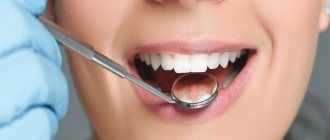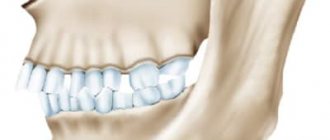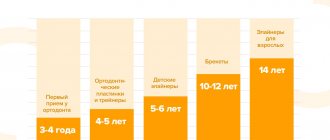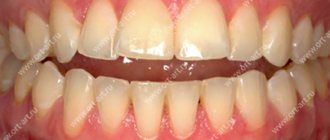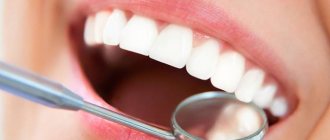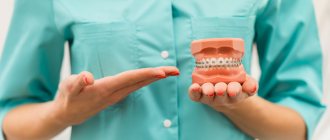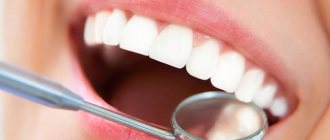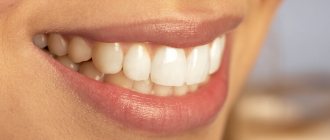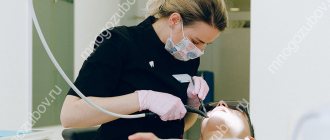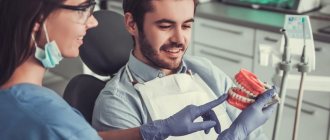This material is intended to inform patients with a diagnosed disease. Do not self-medicate. If you experience symptoms of illness, consult your doctor.
The first removable orthodontic appliances can be used from the age of two. They help rid the baby of bad habits that cause a crooked bite.
In addition, they have a preventive effect:
- regulate the functioning of facial muscles;
- “teach” the tongue to take the correct position at rest, when speaking and when swallowing;
- normalize the position of the jaws relative to each other;
- correct pronunciation and diction by correcting the functioning of the tongue.
Orthodontic appliances can be removable or non-removable. They are used during various periods of bite formation, allowing you to correct the closure of baby teeth or the direction of growth of permanent teeth.
How to identify malocclusion in a child
From the moment the bite begins to change – after the first teeth fall out – you should visit the orthodontist at least once a year. And you definitely need to show your child to a doctor if:
- the teeth of any jaw move forward or go back;
- when closed, the teeth look incorrect;
- newly growing teeth do not have enough space - “chessboard” order, turns, curvatures;
- interdental spaces are visible;
- have supernumerary teeth;
- photographs show the absence of the rudiment of a permanent unit;
- diction is impaired - classes with a speech therapist have no effect;
- I had to remove a molar or pull out a baby tooth before the period of change of bite.
The doctor will examine the child and tell you whether the bite can be corrected on your own or whether it is necessary to use one of the proven correction methods.
Rodikova Tatyana
“The youngest patients are observed at AzaBuka from the age of 3. This is the right approach, as it allows you to avoid pathologies in the development of occlusion and correct all anomalies in record time.”
At what age can a bite be corrected?
The optimal age for treating dental defects in a child is from 5 to 10 years. The formation of the body and the replacement of milk teeth with molars in this interval is well suited for gentle correction with the help of aligners without the need to install heavier systems such as braces. Please note that for children, mild malocclusions are developmentally normal and may improve on their own over time, without orthodontic intervention.
It is better to consult an orthodontist during the period of change of baby teeth - 5-6 years. At this age, it becomes possible to determine the location of future teeth, and, as a result, their defects.
Complex.
It implies a set of corrective techniques to achieve a better result.
Myotherapy and surgery are used infrequently. In the first case, the method is limited by the patient’s age and is used for children 3-5 years old, when the emphasis is on the proper development of masticatory and facial muscles. Surgical techniques are indicated for extremely serious pathologies - when other methods have not helped, and the lack of correction is fraught with serious health consequences.
Most often, orthodontists use an integrated approach - a combination or alternation of hardware techniques.
Correction of deep bite
It takes a lot of effort to correct this effect when a child has baby teeth. In practice, it turns out that improper closure occurs again in a child after the appearance of permanent teeth. Treatment of deep bite involves preschool children performing special exercises, the purpose of which is to develop the medial and lateral pterygoid muscles, which push the lower jaw forward. To coordinate pressure on the teeth of the lower row, the following devices are used:
- Andresen's plate apparatus
- bite blocks
- Klammt activator
- fixed orthodontic devices of various designs
Hardware methods for treating malocclusion
Correction of defects and malocclusions using brackets, plates, and systems shows the best effectiveness. If you follow the rules prescribed by the doctor, the effectiveness of treatment reaches 100%.
Depending on the age of the patient - as well as on the basis of the photographs taken, diagnostics and diagnosis - the orthodontist will suggest:
- records;
- elastopositioners (myofunctional trainers);
- aligners;
- functional devices;
- braces.
Each option has advantages and disadvantages.
Removable plate for straightening teeth in children
A design feature is the presence of mechanical elements in the product. This is usually a screw that, when tightened or loosened, activates a force to move teeth or change the size of the lower or upper jaws.
Among the advantages:
- cost – the cost of producing records is low;
- care – the device is easy to remove during teeth cleaning;
- efficiency - varying mechanical force facilitates rapid correction of mesial or crossbite, as well as the elimination of other anomalies.
- production time - the dental laboratory will create a plate for the child’s bite in a few days.
Flaws:
- inconvenience of wearing - children are irritated by the bulky product in their mouth, so they constantly touch and remove it;
- change in taste sensations - refers to systems created for the correction of the upper jaw, since the plate covers the taste buds on the hard palate;
- violation of diction - due to the location of the product in the space of movement of the tongue;
- easy removal - children remove the device without permission.
Elastic positioners: is it possible to quickly correct a bite?
Elastic positioners are a category of orthodontic products made of silicone that look like sports dental guards. These are orthodontic trainers, LM-activators, mouthguards, Myobrace devices.
Duplicating the correct bite patterns activate the muscles, as a result of which the lower jaw moves into the correct position. Wearing mode: two hours during the day and sleep in the trainer.
Pros:
- convenience - easy to put on and take off, others do not notice the treatment being carried out;
- ease of care – both plates and teeth;
- cost – the price is moderate, it’s easy to buy products;
- bioinertness - allergic reactions are excluded.
Minuses:
- Ignoring treatment by children - they forget to put on the trainer, spit it out at night;
- not suitable for all malocclusion pathologies - sometimes the effectiveness of treatment is extremely low;
- quickly collapse - when the teeth are strongly compressed, silicone loses its integrity.
Aligners for bite correction
Aligners are removable orthodontic aligners made of polycarbonate. Young people often ask: is it possible to correct an incorrect bite with mouth guards? Each case is considered individually!
Advantages:
- aesthetics – the mouthguards are invisible;
- Convenience – easy to take off and put on;
- efficiency - a separate cap is provided for each tooth, which guarantees quick correction;
- low maintenance - rinsing with water and removing plaque;
- safety – do not cause allergic reactions;
- the speed of treatment is no longer than with braces.
Flaws:
- price – a single aligner is cheaper than braces, but the total cost of treatment is high;
- long production time - more than a month;
- not for all bite pathologies.
Functional devices – correction of bite in children
Externally, the devices look like complex structures made of plastic and metal. They are created for a specific bite using impressions taken from the patient’s teeth. The products make the jaw muscles work and are effective in correcting the bite.
Pros of use:
- convenience - easy to remove, do not interfere with food intake, do not require special care;
- for any malocclusion pathologies - subject to the prescribed wearing schedule.
Flaws:
- inconvenient - the child can sabotage treatment;
- require almost constant wearing - the more hours, the better.
Plaksina Margarita
“Sometimes parents ask why I prescribe removable structures if then we still put on braces? It's simple: the effectiveness of functional devices and plates is very high, there is only one problem - violation of the wearing regime. But! If parents work together with the doctor - explain, control, check, then there is no need to install braces.”
Correction of mesial bite
The goal of treating such a malocclusion is to correct the protrusion of the lower jaw or promote the development of the upper jaw. For this purpose the following devices are used:
- Frenkel activator type III
- removable Andresen-Goipl apparatus
- Klammt activator
- Wunderer or Delaire apparatus
- orthodontic cap with chin sling bandage
- Adams, Nord or Schwartz records
- single-jaw stationary Angle arch
In order to inhibit the growth of the bone structures of the lower jaw, children 13-14 years old can undergo dental surgery. During this procedure, the buds of the lower eighth teeth, the so-called wisdom teeth, which begin to grow when the child is between the ages of 6 and 14, are removed.
Crossbite correction
The purpose of treatment: to establish the most correct arrangement of teeth in the row and the position of the child’s lower jaw. If a child with baby teeth has a crossbite, it is necessary to separate the dentition. To do this, crowns or trays are installed on the molars, as well as on the lateral teeth - plate devices with bite plates.
In cases of cross occlusion and severe lateral displacement of the lower jaw, a chin sling is sometimes used. Plate devices, adjustable with screws and springs, are suitable for expanding the dental, alveolar and basal arches of the child’s jaws.
Marco Rosa apparatus
The Marco Rosa apparatus is a non-removable expansion apparatus that is fixed to the palate and supported by temporary teeth. Pros - quick adaptation (including with diction), maximum aesthetics (absolutely invisible to others), rapid expansion of the upper dentition (achieved in just 1 month, then 6-8 months for stabilization), work efficiency regardless of cooperation with the patient (after all, the device cannot be removed independently). The only caveat is that oral hygiene must be excellent (it is necessary to thoroughly clean the teeth and the apparatus itself using a brush-paste and irrigator).
Removable plates
This is the “good old” classic of early orthodontic treatment. Many parents of my young patients talk about their experiences with plate therapy in childhood. Despite the long life of the plates, they do not lose their relevance, since they provide excellent treatment results, and in terms of cost they are one of the most budgetary options for orthodontic treatment.
The main component of the success of treatment is good cooperation, because the plate must be worn 24 hours a day (including school and night time). The disadvantages of the records include problems with diction and the child’s fatigue due to the duration of treatment (usually 1-1.5 years). To make the records, we use only high-quality imported materials; the child can choose any colors, sparkles and pictures so that the treatment takes place with great enthusiasm and pleasure.
Examples of excellent treatment results on plate
Before treatment
After treatment
Before treatment
After treatment
Partial bracket system “2x4”
Metal bracket system 2x4
Ceramic bracket system 2x4
This system is specially designed for treating children aged 8-9 years. Braces are fixed only on the permanent incisors and first molars, which allows you to quickly correct the position of the front teeth and create space for the lateral group of teeth (which begin to change from temporary to permanent from the age of 9).
Pros of partial braces:
- the ability to correct the position of the front teeth even in the most difficult situations;
- speed of treatment (up to 8-10 months);
- the ability to choose the most invisible braces (ceramic).
An important factor during such treatment is maintaining careful oral hygiene using special toothbrushes and brushes.
Examples before and after treatment
Before treatment
After treatment
Before treatment
After treatment
Moving options
There is an opinion that the tooth is fixedly fused to the jaw bone. This is not entirely true. The root of the tooth is firmly attached to the tooth socket by fibers of connective tissue. These elastic fibers are located in the narrow gap between the bone wall and the tooth root. Teeth are able to move independently during eruption and under the influence of certain forces.
When a slight prolonged pressure is applied to the wall of the tooth socket, it dissolves in this place, opening up “prospects” for movement for the causative tooth. On the other hand, where the fibers of the connective tissue are stretched, new bone is formed, which does not allow the “displaced” tooth to return to its original position
Open bite correction
If a child has an open bite, in most cases the upper jaw is narrowed. For this reason, removable expansion plates of various modifications are used, equipped with a spring or screw for children whose permanent teeth have just begun to emerge. They are used for treatment and construction to increase the anterior parts of the upper alveolar arch, to reduce the lateral parts of the alveolar zones, which is selected individually in each case.
If the discrepancy between the incisors and canines is large, for children over 12 years of age, intermaxillary traction techniques using Angle orthodontic devices with additional traction can be used. The second way of correction is the use of plastic mouth guards, which are placed on both jaws (front teeth).
Diagnostics
If you suspect that a child has a malocclusion, even if he is only one year old, you should immediately show him to a pediatric orthodontist at the My Orthodontist clinic. To prevent malocclusion, a child should first be taken to an orthodontist at the age of three.
If the doctor reveals a malocclusion during the examination, then additional diagnostic measures are taken: a panoramic photograph of the jaws, radiography of the skull, making an alginate cast and a plaster model of the dentition. In some cases, computed tomography and myography are used to clarify the diagnosis.
